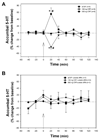Corticotropin-releasing factor 1 and 2 receptors in the dorsal raphé differentially affect serotonin release in the nucleus accumbens
- PMID: 17945210
- PMCID: PMC2276644
- DOI: 10.1016/j.ejphar.2007.09.024
Corticotropin-releasing factor 1 and 2 receptors in the dorsal raphé differentially affect serotonin release in the nucleus accumbens
Abstract
Corticotropin-releasing factor (CRF) is a neurohormone that mediates stress, anxiety, and affects serotonergic activity. Studies have shown that CRF has dose-dependent opposing effects on serotonergic activity. This effect has been hypothesized to be differentially mediated by CRF(1) and CRF(2) receptors in the dorsal raphé nucleus. We directly tested this hypothesis by using in vivo microdialysis to determine the effects of CRF and CRF receptor antagonists in the dorsal raphé nucleus on serotonin (5-HT) release in the nucleus accumbens, a brain region implicated in the neuropathology of stress-related psychiatric disorders. Male urethane-anesthetized rats were implanted with a microdialysis probe into the nucleus accumbens, and CRF (0, 100 or 500 ng) was infused into the dorsal raphé. Infusion of CRF into the dorsal raphé nucleus had dose-dependent opposite effects, with 100 ng of CRF significantly decreasing 5-HT levels in the nucleus accumbens and 500 ng CRF significantly increasing accumbal 5-HT levels. In subsequent experiments, the raphé was pre-treated with the CRF(1) receptor antagonist antalarmin (0.25 microg) or the CRF(2) receptor antagonist antisauvagine-30 (ASV-30; 2 microg) prior to CRF infusion. Antagonism of CRF(1) receptors in the dorsal raphé nucleus abolished the decrease in accumbal 5-HT levels elicited by 100 ng CRF, and CRF(2) receptor antagonism in the raphé blocked the increase in accumbal 5-HT levels elicited by 500 ng CRF. These results suggest that the opposing effects of dorsal raphé CRF on 5-HT release in the nucleus accumbens are dependent on differential activation of CRF(1) and CRF(2) receptors in the dorsal raphé nucleus.
Figures




Similar articles
-
Corticotropin-releasing factor in the dorsal raphe nucleus increases medial prefrontal cortical serotonin via type 2 receptors and median raphe nucleus activity.Eur J Neurosci. 2008 Jul;28(2):299-310. doi: 10.1111/j.1460-9568.2008.06333.x. Eur J Neurosci. 2008. PMID: 18702701 Free PMC article.
-
Selective activation of corticotropin-releasing factor-2 receptors on neurochemically identified neurons in the rat dorsal raphe nucleus reveals dual actions.J Neurosci. 2004 Feb 11;24(6):1305-11. doi: 10.1523/JNEUROSCI.2885-03.2004. J Neurosci. 2004. PMID: 14960601 Free PMC article.
-
Chronic amphetamine treatment enhances corticotropin-releasing factor-induced serotonin release in the amygdala.Eur J Pharmacol. 2010 Oct 10;644(1-3):80-7. doi: 10.1016/j.ejphar.2010.07.008. Epub 2010 Jul 23. Eur J Pharmacol. 2010. PMID: 20655906 Free PMC article.
-
Collateralized dorsal raphe nucleus projections: a mechanism for the integration of diverse functions during stress.J Chem Neuroanat. 2011 Jul;41(4):266-80. doi: 10.1016/j.jchemneu.2011.05.011. Epub 2011 May 30. J Chem Neuroanat. 2011. PMID: 21658442 Free PMC article. Review.
-
Effects of citalopram on serotonin and CRF systems in the midbrain of primates with differences in stress sensitivity.J Chem Neuroanat. 2011 Jul;41(4):200-18. doi: 10.1016/j.jchemneu.2011.05.010. Epub 2011 Jun 6. J Chem Neuroanat. 2011. PMID: 21683135 Free PMC article. Review.
Cited by
-
Negative consequences of early-life adversity on substance use as mediated by corticotropin-releasing factor modulation of serotonin activity.Neurobiol Stress. 2018 Aug 7;9:29-39. doi: 10.1016/j.ynstr.2018.08.001. eCollection 2018 Nov. Neurobiol Stress. 2018. PMID: 30151419 Free PMC article. Review.
-
Behavioral and pharmacogenetics of aggressive behavior.Curr Top Behav Neurosci. 2012;12:73-138. doi: 10.1007/7854_2011_191. Curr Top Behav Neurosci. 2012. PMID: 22297576 Free PMC article. Review.
-
Anxiety and Depression: What Do We Know of Neuropeptides?Behav Sci (Basel). 2022 Jul 29;12(8):262. doi: 10.3390/bs12080262. Behav Sci (Basel). 2022. PMID: 36004833 Free PMC article. Review.
-
An IL-6 receptor antagonist attenuates postpartum anhedonia, but has no effect on anhedonia precipitated by subchronic stress in female rats.Psychopharmacology (Berl). 2019 Oct;236(10):2983-2995. doi: 10.1007/s00213-019-05194-3. Epub 2019 Mar 4. Psychopharmacology (Berl). 2019. PMID: 30830260
-
Stress-hyperresponsive WKY rats demonstrate depressed dorsal raphe neuronal excitability and dysregulated CRF-mediated responses.Neuropsychopharmacology. 2011 Mar;36(4):721-34. doi: 10.1038/npp.2010.200. Epub 2010 Dec 15. Neuropsychopharmacology. 2011. PMID: 21160465 Free PMC article.
References
-
- Amat J, Matus-Amat P, Watkins LR, Maier SF. Escapable and inescapable stress differentially alter extracellular levels of 5-HT in the basolateral amygdala of the rat. Brain Res. 1998a;812:113–120. - PubMed
-
- Amat J, Matus-Amat P, Watkins LR, Maier SF. Escapable and inescapable stress differentially and selectively alter extracellular levels of 5-HT in the ventral hippocampus and dorsal periaqueductal gray of the rat. Brain Res. 1998b;797:12–22. - PubMed
-
- Amat J, Tamblyn JP, Paul ED, Bland ST, Amat P, Foster AC, Watkins LR, Maier SF. Microinjection of urocortin 2 into the dorsal raphe nucleus activates serotonergic neurons and increases extracellular serotonin in the basolateral amygdala. Neuroscience. 2004;129:509–519. - PubMed
-
- Amato JL, Bankson MG, Yamamoto BK. Prior Exposure to Chronic Stress and MDMA Potentiates Mesoaccumbens Dopamine Release Mediated by the 5-HT(1B) Receptor. Neuropsychopharmacology. 2006 - PubMed
-
- Arborelius L, Owens MJ, Plotsky PM, Nemeroff CB. The role of corticotropin-releasing factor in depression and anxiety disorders. J. Endocrinol. 1999;160:1–12. - PubMed
Publication types
MeSH terms
Substances
Grants and funding
LinkOut - more resources
Full Text Sources

